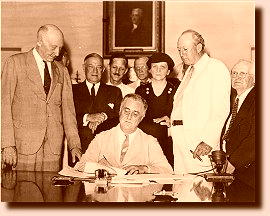
Starting the Biggest Chain Letter in History
Robert Samuelson is one of the best economic journalists around. His latest Washington Post column, “Welfare Junkies” (requires simple registration) offers some insightful analysis of federal retirement policy, but flubs the issue at the end. (It’s still worth a read.)
The flub at the end is the treatment of alleged “benefit cuts” entailed by allowing taxpayers to retain ownership of their earnings and put them into personal retirement accounts rather than having them confiscated and tipped into the “pay-as-you-go” pyramid scheme of Social Security. Those who opt to keep their own money rather than have it confiscated will correspondingly diminish their claim on benefits (the alleged “benefit cut”), but would more than make up the difference by being allowed to invest in stocks (of wealth-producing companies) and bonds. That would reduce the claims on the state and more than offset the diminution by the increase in private retirment income. Furthermore, by changing the rate at which benefits are increased from the growth in wages to the rate of price inflation, the gap between tax income and spending will be drastically narrowed, without any actual cut in benefits. The burden on the taxpayers can be drastically reduced without cutting the real benefits of any class of recipients. Furthermore, the outcome would be that everyone who chose actual investments rather than putting their money into a chain-letter would be out of the government system entirely.
Is it the very best approach I might imagine? No; I would prefer not to have any compulsion at all, including the compelled choice between taxation or investment. But is it a gigantic improvement over the system we’ve got? Yes; it reduces the burden on taxpayers, replaces state-dependency with ownership, and puts an end to an unsustainable chain letter. (More information is available at www.socialsecurity.org and at www.teamncpa.org.)










While I agree that the current system is abysmal, I find many aspects of Bush’s plan troubling. The biggest is this: What will be the lasting effects of the government’s political intervention into the market (incidentally, this is something Samuelson touched upon in a recent column). He writes, “The Social Security system would then become the largest single investor in U.S. stocks. By 2050 Social Security could hold 25 percent of all stocks, estimate economists at Goldman Sachs.” He continues: “What looms is a massive expansion of government power over Wall Street. To be sure, it would occur gradually, over decades, and its outlines are murky.” This is similar to the problem I have with school vouchers. While I support any move away from government control over these important areas, I fear that we might end up erecting a Trojan horse.
I agree that with solvency the system would develop a more comprehensive system of tradable property rights. But with a 7 trillion dollar deficit, and with the administration saying that there would be some “transition costs” is now the time to shift the system over? It needs to be done but I’m not sure now is the time.
“Starting the Biggest Chain Letter in History”, indeed…
“While I agree that the current system is abysmal, I find many aspects of Bush’s plan troubling. The biggest is this: What will be the lasting effects of the government’s political intervention into the market”
I find troubling aspects in all privatization plans I know of and I agree that the risk of increased political intervention in the securities market is a very serious one, but I think we shouldn’t give up on a good (compared to the status quo) solution just because we can’t get the perfect one.
The way I see it, if libertarians want to have an active role in influencing public policy (and I can understand that some legitimately do not), they have to separate the ideal state of affairs from concrete reforms that are, globally, a step on the right direction. I believe Bush’s plan, for all its flaws and risks, to be a significant step in the right direction.
Political philosophy is an important guide for framing positions on public policy but those who mistakingly equate the public policy arena with the realm of “pure” political philosophy (whether libertarian or any other) are sure never to develop any feasible policy proposals.
In no way am I criticizing the Bush plan because it doesn’t deliver us to the promise land. I don’t think my original comment reads that I am. Any step in the right direction is fine by me. My point, however, was that I’m not sure that this is a step in the right direction. I like the rhetoric (and I don’t use this term derisively) of “ownership” and “markets,” but I’m not convinced that it’s what we’ll get. Samuelson (no ideal-state libertarian, by the way) holds the same opinion. In the name of reform, we might end up breaking the golden goose’s legs.
“My point, however, was that I’m not sure that this is a step in the right direction.”
If you think that the risks of more regulation to the securities market outweigh the benefits of allowing, at least to some degree, the opting out of the current pyramidal scheme of Social Security, I think that’s a fair position.
But I think we should also note that even with a public Social Security system the US Governement has never failed to find reasons to intervene in the financial markets…
I agree with Jude that carefully evaluating of this a step in the right direction should be the standard and that it is crucial to do that properly.
What I was trying to point out (and maybe I misread Jude’s original comment) is that it is very dangerous to evaluate public policy options exclusively based on political philosophical ideal states, and I think many good libertarians often do that.
This article on the Federal Employee’s Thrift Savings Plan (TSP) is pretty informative for people who don’t know the basics of it. This it the plan that many have been using as a model for private account investments. Only 5 very broad funds, no individual stocks, VERY low expenses. While one can never underestimate the ability of the Federal government to mess things up, I do believe this sort of arrangement minimizes the risk of the kind ‘intervention’ that some are concerned about.
http://moneycentral.msn.com/content/P109805.asp
Social Security should not be viewed from the perspective of how it is, or how it was, but rather in terms of how it ought to be. The system was introduced in 1935 under vastly different social and economic conditions. What made sense then clearly does not make economic or demographic sense now. As Einstein said, “The significant problem we face cannot be solved at the same level on thinking we were at when we created them.”
In the week following our nation’s 229th birthday, it occurred to me that our founding fathers would be astonished to learn of the arguments against privatization. Our country was founded on the principles of life, liberty, property and the pursuit of happiness without government intrusion. The foundation of our economic existence — capitalism — is based on an individual’s right to exist, work and profit from his own productive means. That is to own and control capital. Individual rights, freedom, justice, and progress are the values, goals and practical results of capitalism. If one believes in freedom, then one must believe in a one’s right to choice, ownership and inheritability. All of which are denied by today’s Social Security system.
My guess is that the most vehement opponents to Social Security privatization do not know that current workers have no legal or contractual right to future benefits. According to the United States Supreme Court, Social Security is not an insurance program. FICA (federal insurance contribution act) despite the name is not insurance, it is as one scholar put it, a “noble lie” for taxes not contributions or insurance. Social Security is a tax like any other and can be spent by our government at will. Today’s “public pension” program is nothing more than a fancy IOU with an incredibly poor ROI.
According to Arizona State University’s Nobel Prize laureate Dr. Ed Prescott, today’s worker can expect to receive somewhere between a positive .86% and negative .72% return on their payroll taxes depending on their annual income. Risk free government bonds would be infinitely more attractive if privatization were on the table.
The problem is that people, especially politicians, see only what they are prepared to see. Organizations like AARP have used scandals (such as Enron) to create fear and uncertainty about privatization.
In the end the facts remain the same. Social Security is more like Enron today, than it would be under reform. Americans should uphold and protect the right of each worker to save and invest for their future. We must uphold a political and economic system that safeguards these rights. Al Gore was correct when he said that Social Security should be held in a lock box — a privately owned lock box outside of government control. It is critical that we recognize Social Security for what it really is create a true and honest social insurance program.